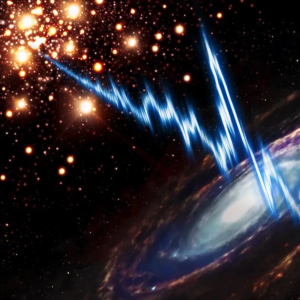Ultra-fast radio flash from a globular cluster. Credit: Daniëlle Futselaar / ASTRON.
–
In recent years, several remarkable mysteries have appeared in space that scientists do not yet know much about. They also include fast radio jets FRB (Fast Radio Bursts), ie short and at the same time very intense radio screams, which we hear from deep space. We have already detected a number of them, but unfortunately this mystery seems to deepen with each new observation and research. We still don’t understand fast radio flashes and maybe we’re missing something important.

Franz Kirsten. Credit: F. Kirsten.
–
New research by an international team led by Franz Kirsten of Sweden’s Chalmers University of Technology continues this remarkable trend. Recently, they detected more fast radio flashes – and they couldn’t stare. They are so different from those known so far that they may represent a whole new class of these signals. The new signals are about a million times shorter than usual for fast radio flashes, suggesting that we may still be overlooking a large number of them. Another note is that they arrived from an area from which virtually no one would expect them.
These are radio signals from the space of the constellation Ursa Major, which were detected in January 2020. Researchers used European VLBI Network radio telescopes to track the radio cry to its source. It turned out that it arrived from the edge of the spiral galaxy Messier 81, which is about 12 million light-years away. At first glance, this looks impressive, but most fast radio jets arrive from much greater distances, often billions of light-years.
 –
–
Elegant Spiral Galaxy Messier 81. Credit: Ken Crawford / Wikimedia Commons.
–
Kirsten and colleagues even discovered that the ultra-fast radio flash came from a globular cluster, a densely arranged flock of old stars. This is completely atypical for fast radio jets known so far. Usually the opposite is true. Among the main suspects in the production of fast radio flashes are magnetars, ie pulsars with extreme magnetic fields. However, the globular cluster is a place where you would definitely not look for a magnetar.
So where did the ultra-fast radio flash come from? Kirsten points out that during the billions of years of the evolution of the globular cluster, a number of strange things may have happened. With colleagues, they believe that the cause of the detected signals could be a star (or its remnant) with an exceptional history. As for the magnetar, it’s certainly not “ordinary” – although this phrase sounds pretty weird for such extreme and rare objects as magnetars. In this case, it could be a binary star with a white dwarf stealing matter from his partner. It did not explode like a supernova, but it could collapse into a magnetar. This should be quite exceptional – but it is said to be the easiest explanation for the source of the fast radio flashes in the cluster.
However, this hypothesis is also quite water. When it turned out that some of the signals from this ultra-fast radio flash lasted only a few nanoseconds, we found ourselves in the dark again. Such an extremely short signal should come from a very small body, according to calculations with a diameter of perhaps only a few tens of meters – and at the same time extremely energetic. The mystery lasts, only in addition to the classic fast radio flashes, we also hunt their ultra-short version.
Literature
Nature Astronomy online 23. 2. 2022.
–


